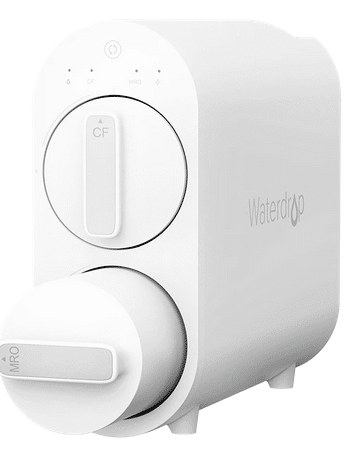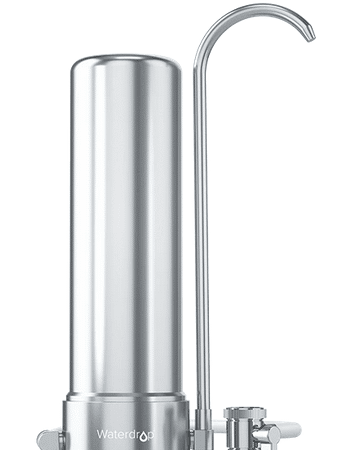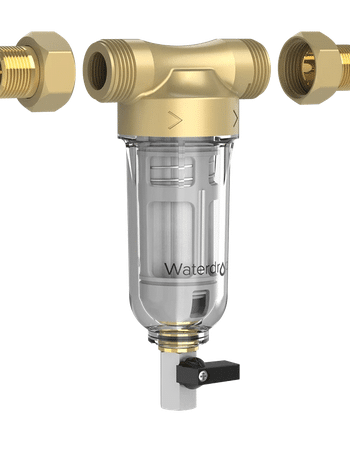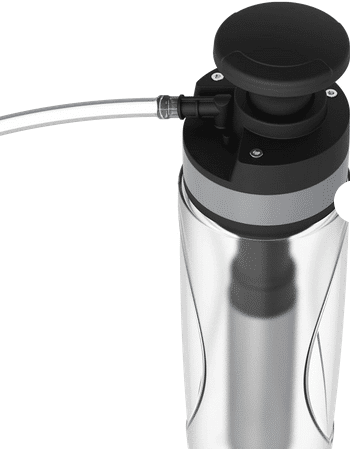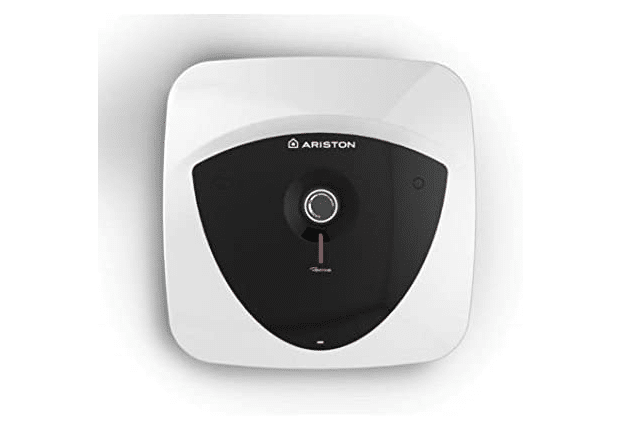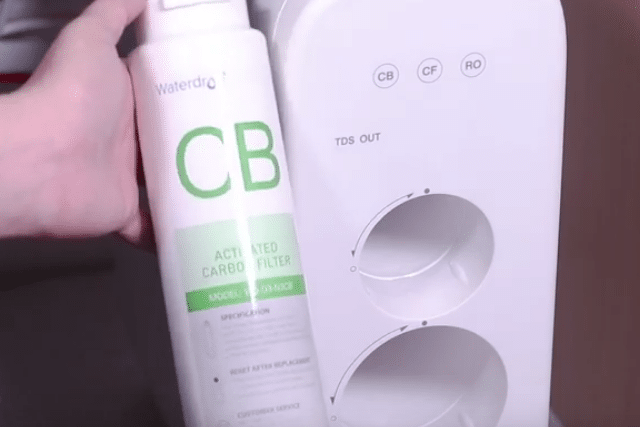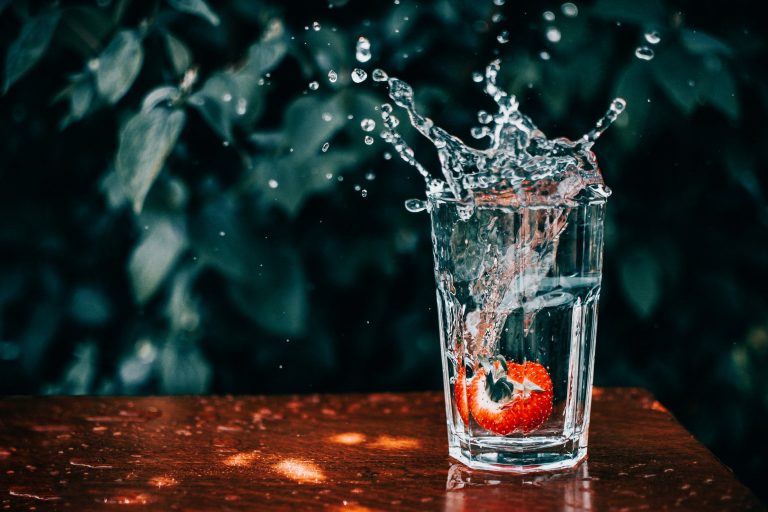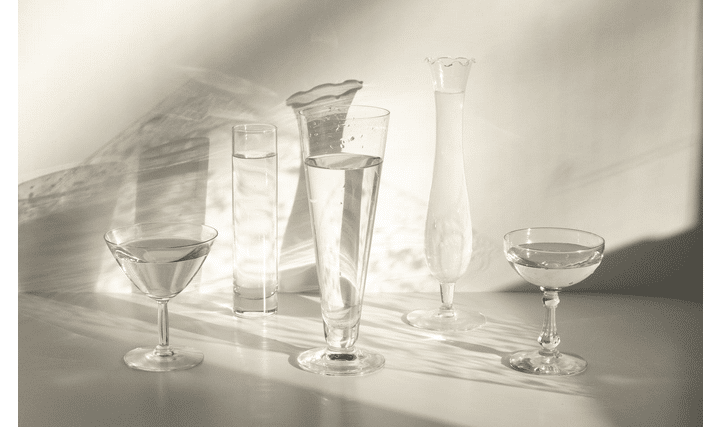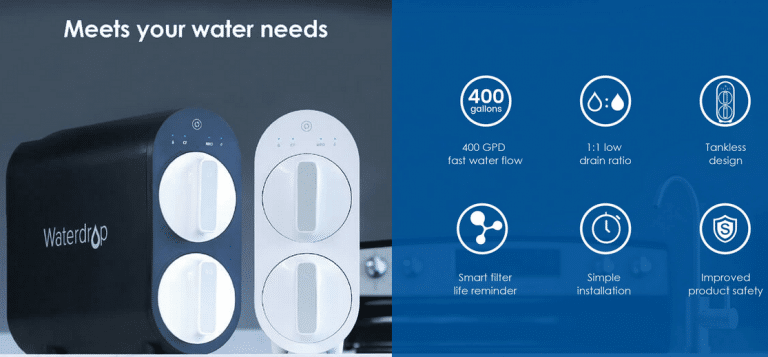Waterdrop Filter Review and Guide 2022
Waterdrop filters make are useful at purifying water. They remove things like sand, silt, and heavy metals as well as pesticides and disease-causing pathogens.
This means that using the filters, you can turn water that was unfit for drinking into potable water.
By getting rid of all those things, these filters improve the appearance of the water. They also remove odor and taste from the water. That is, of course, on top of improving the water’s safety.
Water that has gone through a Waterdrop filter will typically have a crystal clear look. This crystal clear look gives you confidence in drinking the water – because it truly looks pure.
Waterdrop Filter Review
Whether you are looking for a reverse osmosis or countertop filter, you will easily find an ideal product from Waterdrop.
The same applies whether you are looking for an outdoor, fridge, under-sink or whole house filter. This is to say that Waterdrop has a whole range of water filter solutions.
Waterdrop filters have come to be greatly loved mainly on account of their effectiveness. It helps too that most of these filter systems are quite easy to install, and tend to be quite durable.
Their elegant, compact design is one more thing that tends to draw people to them. Waterdrop filters may not always be the cheapest in the market.
But they do tend to offer great value for money. That becomes clear when you compare their quality to the prices at which they are sold. Granted, there may be lots of other water filter systems. But those under the Waterdrop brand have over the years come to win acclaim.

6 Best Waterdrop Filters We Highly Recommend
1. 600GPD Reverse Osmosis Waterdrop Filter System
This Waterdrop filter is capable of sieving up to 600 gallons per day. It is one of those water filter systems that come without tanks. Therefore with this system, filtration takes place in real-time. The moment you turn on the tap is the moment when filtering happens. There is no storage tank. And that is ideal because water storage often leads to a build-up of bacteria and other pathogens. The fact that it comes without a storage tank also makes it compact. This means that it doesn’t occupy much space.
The water that has undergone filtration in this system comes out through a faucet. According to the system’s vendors, this faucet is made from brushed nickel. And it is lead-free.
The large filter area at the core of the system yields greater filtration power. It is able to filter more water, faster and in a more thorough way. Besides having a large filter area, this system is based on the 5 filters into 1 design paradigm. This enhances its power even further.
With this filter system, it is easy to view the TDS level as well the remaining filter life. That is thanks to the screen which you will find somewhere close to the filter system’s output faucet.
2. Waterdrop Replacement for Samsung (HAF-CIN/EXP) Fridge Water Filter
This Waterdrop fridge filter promises to deliver up to 600 gallons of water before it wears out. That is about 6 months of service, before it loses its potency. It is the sort of filter you place within a fridge. Then it filters the water directly as it comes out of the fridge. You thus get cleaner and safer water at a cool temperature.
Besides the HAF-CIN/EXP Samsung fridge, this filter is compatible with several others, including RF4287HARS and Kenmore 46-9101.
It is very easy to install onto compatible fridges. The entire process of putting it in place shouldn’t take you more than a minute. In most cases, putting it in place is a tool-less process. Once in place, it offers solid protection against sediment, rust and dirt in the water. It is also able to filter out chlorine to a good degree, besides other chemicals like benzene, lead and estrone.
It helps that this is a filter that has undergone NSF testing, and gotten good scores. In comparison to other fridge water filters with similar power, this filter’s price is quite low. See waterdrop G2 vs G3 Review
3. Countertop Faucet Waterdrop Filter System
This Countertop water filter is one of those that replace water impurities with useful minerals. So on the one hand, it removes impurities from the water. Then, on the other hand, it adds minerals like magnesium and calcium to the water.
Some of the impurities it removes include sediment and chlorine. It also shows good power at removing colloids.
The best thing about this filter is really in the amount of safe water it can deliver. That is the amount of safe water it can deliver before it wears out. The figure is around 8,000 gallons.
That is up to 10 times what most other filters can deliver before they wear out. Again most other filters tend to wear out within 6 months. This one works for up to 12 months before wearing out.
This water filter system is designed to connect seamlessly with the standard kitchen tap faucet. Therefore you don’t have to worry too much about compatibility, as long as your faucet is of standard kitchen size.
Further, you don’t have to worry about the possibility of the filter system itself messing up your water. That is because the filter system’s core material is food grade stainless grade. Food-grade stainless steel has no possibility of spoiling your water.
Another notable thing about this filter is the fact that it works via a 5-stage filtration process. The water that comes out at the end of that process truly looks clean. And it has no odor and is pretty much tasteless.
Another key thing in this filter system is the easy-to-use tap/pure water switch it comes with. Thus you don’t have to remove the filter whenever you want to get unfiltered tap water. You just engage the switch, and the system stops filtering: thus giving you basic tap water on demand.
4. Under Sink Water Filter | Direct Connect Filtration System
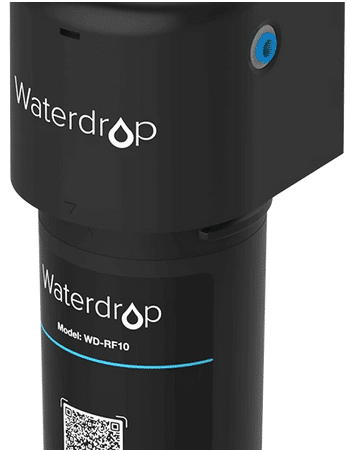
This is a push-to-connect Waterdrop filter that easily goes under the sink. It is capable of ridding water of all sorts of odor and sediment. This filter is also effective at removing chlorine from the water as well as any heavy metals.
It is one of those waters filters that work via a multi-stage filtration process. Such filtration ensures that pretty much no impurity manages to escape. That is because the impurities that sneak through the first filtration stage are surely caught in the second stage.
Those very few that manage to escape the second stage have almost no chance of sneaking past the third stage… and so on.
You can get up to a max of 19,000 gallons from this filter system. That is within a span of up to 36 months.
This water filter has a twist-and-lock installation design. This means that no tools are necessary for its installation. You just locate the spot where it should go, place it there, then twist and lock it onto place.
There have been concerns about water filter systems that contain lead. This one is absolutely lead-free. Therefore you can use it with confidence that your water won’t end up acquiring heavy metal stuff from it.
It has a fast flow rate. This is the sort of water filter with which you can fill a glass within seconds. With this filter, it often feels almost as good as if you were getting the water directly from the tap. That is in spite of the water has gone through multi-stage filtration.
5. Reusable Whole House Spin Down Sediment Water Filter (50 Micron)
This filter may be ideal if you notice that the main impurity in your water is sediment. While some other filters have only modest efficacy against sediment, this one removes all traces of it in water. That is possible thanks to the filter’s 50 micron media: which allows almost no grain of sediment to escape. Besides sediment, it also has good effect in removing rust and small objects from the water.
This is the sort of filter you can install close to where the water line enters your house. It then traps sediment and other big impurities. It thus reduces the work that other filters you install down the line have to do. In so doing, it would also enhance the efficacy of those other filters.
Most other water filter systems have an effect on water pressure. This one doesn’t. That is very important for a whole house filter system. Therefore you can install it without worrying about messing up with your water pressure. With this filter system, you can get up to 20 gallons per minute. That is good enough for most people’s needs.
Another key thing about this filter is the fact that it works via a spin-down mechanism. That translates into greater effectiveness at water impurity removal. By virtue of the fact that it works via spin-down mechanism, it is different from most other filters. It may therefore work where other filters have failed to deliver.
It is also worth noting that this filter has a backwash function. This means that the removal of sediment and other impurities it traps is easy. You just use the backwash function, and then the filter pretty much cleans itself.
6. Outdoor Portable Waterdrop Filter Pump
![]() This water filter pump has the capacity to deliver up to 1,320 gallons of water. Within the filter is Tritan material. Besides aiding in impurity removal, Tritan also protects your water from secondary pollution. With this filter, you can remove impurities from not only tap water but also well water.
This water filter pump has the capacity to deliver up to 1,320 gallons of water. Within the filter is Tritan material. Besides aiding in impurity removal, Tritan also protects your water from secondary pollution. With this filter, you can remove impurities from not only tap water but also well water.
It also works with river water, lake water… and so on. It can therefore be very useful while going camping. It can also be useful while traveling to areas where a safe water supply is doubtful.
The design of this water filter makes it very easy to carry from place to place. You can easily load it onto a backpack bag without challenges. It is light in weight. Yet it is also very sturdy – making it easy to carry from place to place.
Most other filters only seem to work well with tap water. They have severe limits when it comes to well water. Not this one. This filter is unique in that it is capable of handling well water. This is therefore the sort of filter that has real power for turning truly unsafe water into genuinely potable water.
At the core of this filter is ceramic media. It rids water of impurities via nano-metal clusters. It also contains active carbon fiber. These two elements together ensure that the water that goes through the filter comes out with absolutely no odor. This also ensures that the water that goes through comes out without rust, sediment, dirt and other common impurities.
Buying Guide: Is a Water Filter a Worthwhile Investment?
To understand whether a water filter is a worthy investment, you need to ask yourself one key question. That is as to what would be the effects of drinking water that has impurities. And the answer is that the effects of drinking such water can be costly.
In the short term, you may be looking at all sorts of stomach problems. Those would be on account of drinking water that has bacteria and other disease-causing pathogens.
In the long term, you could be looking at systemic illnesses. These may come from long term consumption of heavy metals, pesticides, and pharmaceutical residues in the water. In the immediate term, there would of course be the unpleasantness of drinking water that looks impure.
That would also be on account of drinking water that has strange odors/tastes on account of various impurities. To the extent that a water filter can help you avoid these things, it would be a worthy investment.
Of course, the filter is only a worthy purchase to the extent that it can truly remove impurities from water. In this regard, there are Waterdrop filters with up to 99.9% efficacy at removing various impurities from water. That surely makes them worthy purchases.
Do waterdrop filters actually work?
The question as to whether water filters actually work is one that arouses a great deal of controversy. To find the answer to it, we need to understand how these filters operate.
We also need to look at the water that has undergone filtration. Then compare it with water that has not undergone filtration.
With regard to how water filters work, it turns out that the filters usually have gauze-like membranes. The water that is being filtered is made to go through those membranes.
They trap physical impurities – like sand, silt, sand, and so on. Therefore by the time the water comes out of the filter system, it is free of such physical impurities.
Besides the gauze-like membranes, the filters also usually have activated carbon. This helps remove chemical impurities that the membrane couldn’t trap.
These include chlorine, pesticides, and pharmaceuticals.
With regard to the comparison between water that has undergone filtration and water that hasn’t undergone filtration, one thing is clear. Water that has undergone filtration tends to look cleaner.
It looks purer. And it tends to be taste-free and odor-free. On the other hand, water that hasn’t undergone filtration often has some sort of discernible taste, and sometimes odor.
Therefore looking at the ways through which water filters operate, it is clear that they actually work. The same applies after comparing water that has undergone filtration to water that hasn’t.
It is clear that water filters do work. Of course, the filtration power of any given filter will depend on how it is built. It will also depend on whether or not the filter material still has potency.
So we have dealt with the question as to whether water filters work. We can now proceed to look at the top 6 Waterdrop filters.
Important Features In a Water Filter
The first thing you need to look for in a water filter is the list of things it can remove. There are some filters that are only capable of removing physical impurities (such as sediment, rust, and other small objects). There are others that are capable of removing chemical impurities (like chlorine, fluorine, heavy metals, and so on).
We even have some that are capable of removing odors and tastes from water. You need to understand the main impurities that are in your water supply. Then only go for a filter with the capacity to fully remove those. Also, make an effort to understand the filtration process. Understand what the filter media is, how many stages the filtration process has… and so on
Consider the potential life of the water filter. Some can last up to 6 months. Others up to 12 months. We even have some that do up to 18, 24, and 36 months respectively. Go for a filter that will serve you for a reasonable period of time. Also, consider the amount of water that the filter can purify before it loses potency. That is usually stated in gallons.
If you use well water, only go for a filter that can work with that type of water supply. Not all filters can work with well water (or river/lake water). Therefore enquire on this.
The ease of installation for the filter is important. So is its size/compactness. You also need to understand whether the filter has BPA (or it is BPA-free). And whether it has lead (or it is lead-free).
Consider checking about the testing that the filter you are thinking of buying has been subjected to. Filters that have, for instance, do well in independent NSF tests may be better.
How to install a water filter
Specific installation steps depend on what type of filter it is. Countertop filter installation may be different from that for a fridge filter. But most Waterdrop filters tend to have a push-to-connect design. So yours is to first identify the mounting where the filter is supposed to go.
Alternatively, you need to prepare the mounting, if you are doing a first-time installation. Then you push the filter onto the mounting. Thereafter, you need to twist the filter, in order to lock it in place. You can then complete the connection, by getting the water supply faucet to enter the filter at the right point.
For a reverse osmosis filter, you would also need to connect to a power source. For an under-sink filter or countertop filter, you may need to bore a hole through which to pass the faucet.
Raindrop filters usually come with elaborate user manuals. Those even have diagrams to aid you in installation.
Most of the Waterdrop filters are so easy to install that you can do it yourself. But there are a few for which you may consider calling in an expert plumber.
How To Use A Waterdrop Filter
You first of all need to ensure that the filter media inside still has potency. In other words, the material needs to have the power to trap impurities from water, for it to be useful.
Then connect the filter to the ‘raw’ water supply line. (That is if you didn’t do so during installation). Turn on the ‘raw’ water supply.
Upon doing this, the water will flow into the filter. After filtration, pure water will emerge from the other end. If your filter is working properly, the water coming from the filter will be different from the water entering.
The water coming from the filter will be clearer, with no taste and with no odor.
Yours is to have a glass with which to capture the filtered water.
Note that for some water filters (for instance those that use reverse osmosis), you need electricity for filtration to happen. There are others that only filter when pumping is done manually.
That, for instance, is the case with the Waterdrop Outdoor Portable Water Filter Pump.
How To Maintain A Waterdrop Filter
There are two key ways in which you need to maintain your water filter. So you need to do these things to keep it working well.
Firstly, you need to be regularly clean the filter media. This is the gauze-like material, which traps impurities from the water. It usually requires frequent cleaning, in order to maintain its power.
Your filter user manual is likely to have instructions on how to go about this sort of cleaning.
In most cases, it simply entails putting the filter media material under running water. The water then washes off impurities from the media, leaving it fully clean.
Secondly, you need to change the filters as soon as they lose potency. Some filter systems have screens through which you can see how much potency is remaining in the filters.
Otherwise, you may just start noticing that the filter is not working as well as it used to.
That would be on the basis of the quality of water coming out of it. At that point, it can make sense to replace the filter.
Frequently asked questions
Which is the best Waterdrop filter?
The best Waterdrop filter is the one that removes most impurities.
It is also one that has a good gallons per minute (water flow) rate. And it is one that maintains its potency for long.
Or it is one that can deliver many gallons of water before losing potency. In the reverse osmosis water filter category, the Waterdrop 600 GPD Reverse Osmosis System is good.
In the fridge water filter category, Waterdrop Replacement for Samsung HAF-CIN/EXP filter is good.
And in the Whole House filter category, the Reusable Whole House Spin Down Sediment Water Filter (50 microns) is good. For the outdoors category, the Waterdrop Outdoor Portable Water Filter Pump may be one of the ideal ones.
How Do Water filters work?
Water filters work by simply trapping impurities from water. Thus impurities that would otherwise have gone into the drinking glass remain on the filter.
The person using the filter system gets purer water. The filters contain gauze-like material at their cores. That material traps impurity that would otherwise have flown through.
`Besides physical impurities like sediment and rust, the filters also remove bad chemicals.
Those are things like chlorine, fluorine, and various pesticides. Besides the filters that work through simple entrapment mechanisms, we also have others that use reverse osmosis.
The latter typically have even higher power for the removal of chemical stuff.
What is the price of the Waterdrop filter?
Some like the 600 GPD Reverse Osmosis Water Filter system are quite costly: going for up to $399.
Others like the Outdoor Portable Water Filter Pump cost much less: in the $39.99 range.
Most of the Waterdrop filters seem to cost between $17.99 and $79.99.
The $17.99, for instance, is for the likes of the Waterdrop Replacement for the Samsung HAF-CIN/EXP fridge water filter. The $79.99 on the other hand is for the likes of the Waterdrop Countertop Faucet Water Filter System.
What is the Waterdrop filter flow rate?
The water flow rate depends you get from a Waterdrop filter depending on the input pressure. It can be as little as 0.75 GPM or 1.6 GPM. It can also be as high as 20 GPM.
Conclusion
The most ideal water filter is one that truly purifies water. That is by removing all (or at least most) impurities from it. The 6 Waterdrop filters we have looked at here have proven power in that regard.
The 600 GPD Reverse Osmosis Water Filter System works via reverse osmosis, to remove physical and chemical impurities from water.
The Waterdrop Countertop Faucet Water Filter System is ideal for counter-top use.
On the other hand, the Waterdrop Outdoor Portable Water Filter Pump is ideal for outdoor use.
The Waterdrop Replacement for Samsung HAF-CIN/EXP Fridge Water filter is ideal for in-fridge use. And the Waterdrop Reusable Whole House Spin Down Sediment Water Filter (50 microns) is ideal for whole-house use. Because of their decent efficacy at purifying water, we endorse these 6 Waterdrop filters.

